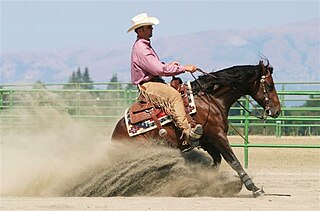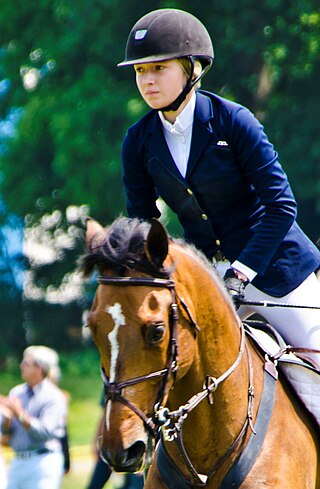Show jumping is a part of a group of English riding equestrian events that also includes eventing, hunters, and equitation. Jumping classes are commonly seen at horse shows throughout the world, including the Olympics. Sometimes shows are limited exclusively to jumpers. Sometimes jumper classes are offered in conjunction with other English-style events. Sometimes, show jumping is but one division of a very large, all-breed competition that includes a very wide variety of disciplines. Jumping classes may be governed by various national horse show sanctioning organizations, such as the United States Equestrian Federation or the British Showjumping Association. International competitions are governed by the rules of the International Federation for Equestrian Sports.

Equestrianism, commonly known as horse riding or horseback riding, includes the disciplines of riding, driving, and vaulting. This broad description includes the use of horses for practical working purposes, transportation, recreational activities, artistic or cultural exercises, and competitive sport.

Reining is a western riding competition for horses where the riders guide the horses through a precise pattern of circles, spins, and stops. All work is done at the lope, or the gallop. Originating from working cattle, reining requires the horse to be responsive and in tune with its rider, whose aids should not be easily seen, and judges the horse on its ability to perform a set pattern of movements. The horse should be willingly guided or controlled with little or no apparent resistance and dictated to completely. A horse that pins his ears, conveys a threat to his rider, refuses to go forward, runs sideways, bounces his rear, wrings his tail in irritation, or displays an overall poor attitude is not being guided willingly, and is judged accordingly.If a horse jogs or breaks gait it is a 0.

Equitation is the art or practice of horse riding or horsemanship.

The United States Equestrian Federation is the national governing body for most equestrian sports in the United States. It also recruits, trains, and governs American teams in international equestrian competition at the Olympics and other competitions governed by the International Federation for Equestrian Sports (FEI).

The Hunter division is a branch of horse show competition that is judged on the horse's performance, soundness and when indicated, conformation, suitability or manners. A "show hunter" is a horse that competes in this division.

Hunt seat is a style of forward seat riding commonly found in North American horse shows. Along with dressage, it is one of the two classic forms of English riding. The hunt seat is based on the tradition of fox hunting. Hunt seat competition in North America includes both flat and over fences for show hunters, which judge the horse's movement and form, and equitation classes, which judge the rider's ability both on the flat and over fences. The term hunt seat may also refer to any form of forward seat riding, including the kind seen in show jumping and eventing.
The United States Hunter/Jumper Association, or USHJA, is the governing body for hunt seat and show jumping in the United States. The mission statement of the USHJA is "to unify and represent the hunter and jumper disciplines of equestrian sport through education, recognition and sport programs". The organization is an affiliate of the United States Equestrian Federation (USEF).

Western riding is considered a style of horse riding which has evolved from the ranching and welfare traditions which were brought to the Americas by the Spanish Conquistadors, as well as both equipment and riding style which evolved to meet the working needs of the cowboy in the American West. At the time, American cowboys had to work long hours in the saddle and often over rough terrain, sometimes having to rope a cattle using a lariat, also known as a lasso. Because of the necessity to control the horse with one hand and use a lariat with the other, western horses were trained to neck rein, that is, to change direction with light pressure of a rein against the horse's neck. Horses were also trained to exercise a certain degree of independence in using their natural instincts to follow the movements of a cow, thus a riding style developed that emphasized a deep, secure seat, and training methods encouraged a horse to be responsive on very light rein contact.
George H. Morris is an American equestrian. He won team silver in show jumping at the 1960 Rome Olympics and is considered a founding father of hunt seat equitation. He was chef d'equipe for the United States show jumping team, which won Olympic gold under his leadership, from 2005 until 2013. He also served as chef d'equipe for the Brazilian show jumping team at the 2016 Rio Olympics. Throughout his career, Morris has been a "proponent of the forward seat" and wrote several books on the subject, including Hunter Seat Equitation. Morris trained students at his Hunterdon Stables and traveling clinics, producing nationally and internationally successful riders, including Olympic champions. In 2019, after a United States Center for SafeSport investigation, Morris was banned for life from the United States Equestrian Federation (USEF) due to sexual misconduct with minors. Morris is likewise banned from coaching international teams for any country.
Equestrian Canada, formerly known as Equine Canada and commonly known by its acronym, EC, is Canada’s comprehensive national governing body for equestrian sport. It is the executive branch of Canada's Olympic and Paralympic equestrian teams; the national association and registry of Canadian equestrian athletes; the national regulatory body for equestrian coaches, competition organizers, and judges; and the national federation of Canadian horse breeders and Canadian breed registries.

Lead refers to which set of legs, left or right, leads or advances forward to a greater extent when a quadruped animal is cantering, galloping, or leaping. The feet on the leading side touch the ground forward of its partner. On the "left lead", the animal's left legs lead. The choice of lead is of special interest in horse riding.

The National Collegiate Equestrian Association, formerly known as Varsity Equestrian, was created as the governing body for NCAA Equestrian teams. The NCEA is headquartered in Waco, Texas. Currently the NCEA has 24 official member colleges and universities that sponsor women's equestrian teams that participate in intercollegiate competition as a varsity sport. Some schools are further organized into conferences while others are not. Most schools sponsor women's teams while two sponsor men's.
The Ontario Collegiate Equestrian Association (OCEA) is a university equestrian league in the province of Ontario, Canada. It was developed to give Ontario post-secondary students an opportunity to participate in equestrian sports while continuing their education. The OCEA welcomes riders of all skill levels, offering hunter seat equitation classes from beginner to advanced riders. The OCEA is team-focused, but allows for personal growth and learning. It allows any post-secondary student to participate in horse shows regardless of the rider's beginning skill level, financial status, or past riding experience. Both men and women are eligible to compete. There are 18 participating universities. Two colleges, Cambrian College and Georgian College, joined for the 2016–2017 season. The league was modelled after the American IHSA.
The Georgia Southern Equestrian Team (GSUET) is a club sport available to students at Georgia Southern University. The club develops an understanding in equestrian activities and horsemanship and unites collegiate horse owners, riders, and anyone interested in horses. It introduces members to equine activities in the community. Team members who join the Intercollegiate Horse Show Association (IHSA) compete with other IHSA team in horse shows hosted by different barns in the southeast. Individuals and the team compete in Zone 5, Region 3 of the IHSA. Each member takes two lessons a week. The Georgia Southern Equestrian Team students are taught grooming, feeding, and health care skills. All riding disciplines are presented and the facility provides well-trained horses for the riders. The GSUET is funded mostly by its members' team fees. However, each year the team is also allotted a budget from Georgia Southern's CRI. Many of the saddles and other tack used by the team are purchased through CRI. Team members pay for their own riding lessons, riding attire, show clothes, and entry fees for shows.

Junior Hunter Finals is a two-day national championship held by the United States Equestrian Federation at two different coasts of the United States in the summer of every year. It is held for qualifying Junior Hunter riders who show at either the 3'3" or 3'6" height.
The Interscholastic Equestrian Association (IEA) is a nonprofit organization that gives youth in grades 4-12 the opportunity to compete in team and individual equestrian competition without the financial outlay of owning a horse. IEA offers competition across three disciplines: hunt seat, western, and dressage. Within each discipline, there are divisions for beginning through advanced riders. Riders compete on horses unfamiliar to them, and there are regulations for the placement of riders new to IEA to account for the unique format. IEA was founded in spring of 2002, and has since grown its membership to 14,500 members across 46 states. Teams can be formed through a school or riding stables.

The United States Equestrian Federation Pony Finals is an annual championship for pony hunters, jumpers, and equitation. The event takes place over six days and is typically held at the Kentucky Horse Park in Lexington, KY. More than 600 ponies compete at the championship every year.

Lillie Carmichael Keenan is an American show jumping rider. As a junior rider she won the ASPCA Maclay Finals, the USEF Medal Finals, and the Washington International Horse Show Equitation championship, as well as the USHJA International Hunter Derby Finals and double gold at the North American Young Rider Championship.











